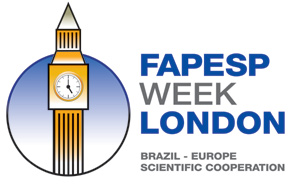Cooperation between universities and industry
Panel at FAPESP Week London stresses the importance of this relationship in conducting research and explains the differences between the United Kingdom and Brazil
By Carlos Eduardo Lins da Silva, in London
Agência FAPESP – Research cooperation between universities and industry was the topic of the opening panel for the final day of FAPESP Week London on Friday, chaired by physicist Marcelo Knobel of the University of Campinas (Unicamp), scientific coordinator of the event in the British capital.
It was clear from speaker presentations that this relationship is established, deep-rooted and productive in countries like the UK, but has only recently begun to achieve a more mature stage in Brazil.
Simon Campbell, former president of the Royal Society of Chemistry, spoke about how the Royal Society, of which he is a member, “an essentially academic entity,” has viewed collaboration with industry as one of its strategic activities for centuries, since the time of James Watt, who patented the steam engine in 1769.
The Royal Society’s 2012-2017 strategic plan emphasizes the principle that a great deal of innovative scientific research occurs in industry, ensuring that both the business sector as well as the general public play an active role in the entity. The plan also encourages translational science and places a priority on communication of science to society.
Among the various activities of the Royal Society to stimulate the relationship between academia and the private sector is the annual event known as “Labs to Riches,” that confers the Brian Mercer Award for Innovation to promote ideas in scientific research that may be commercially exploited through venture capital investments.
The Royal Society also offers programs that allow university scientists to work on research projects at companies and vice-versa for periods of between six months to one year. It also offers financing to startups, short internships to scientists to work in civil service offices and at Parliament, as well as short courses about innovation and business, all designed, according to Campbell, to “build bridges” between science and society.
Tony Hey, vice-president of Microsoft Research Connections, was the session’s second speaker. He spotlighted the cooperation his company has given FAPESP since 2006, a period in which 20 research projects were approved, with emphasis on environmental topics since 2011.
Hey said that collaboration with FAPESP is one of the things Microsoft deems most important, and it has served as an example of one of the five models of cooperation with academia that the company has adopted, namely: simple and direct funding (to help foment speculative research), consortia (such as those the company maintains with MIT’s Media Lab and NYU’s Center for Urban Science), large projects (like the sugarcane genome project it has with FAPESP), research centers (such as those at the universities of Berkeley and Illinois) and joint workshops (that function as precursors to larger projects).
Sérgio Queiroz, coordinator of the research for innovation area of FAPESP, described the Foundation’s programs for this type of activity, particularly the Innovative Research in Small Businesses Program (PIPE) and the Partnership for Technological Innovation (PITE).
Queiroz stressed that most Brazilian academic institutions are relatively young and stated that cooperation between university and industry in Brazil as a whole has improved in recent years. “We’re beginning to establish a more mature relationship in Brazil.”
David Jones, technology director of the BG Group, concluded the panel. He said that among the main objectives of his company in Brazil is building an R&D infrastructure for his company there and helping to increase Brazilian academic capacity. He also mentioned the agreement between the BG Group and FAPESP signed during the opening ceremony of FAPESP Week London.
According to Jones, important factors for the success of cooperative efforts between universities and industry include the existence of a real connection between the research and the company’s business strategy, commitment to long-term projects, and alignment and convergence of institutional perspectives between the partners.









